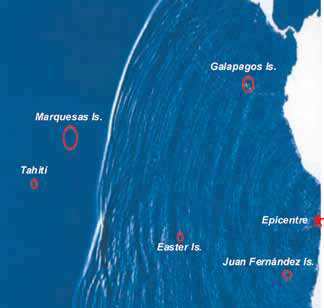tsunami propagation
 Tsunamis travel outward in all directions from the generating area, with the direction of the main energy propagation generally being orthogonal to the direction of the earthquake fracture zone. Their speed depends on the depth of water, so that the waves undergo accelerations and decelerations in passing over an ocean bottom of varying depth. In the deep and open ocean, they travel at speeds of 500 to 1,000 km per hour (300 to 600 miles per hour). The distance between successive crests can be as much as 500 to 650 km (300 to 400 miles). However, in the open ocean, the height of the waves is generally less than a meter (3 feet) even for the most destructive teletsunamis, and the waves pass unnoticed. Variations in tsunami propagation result when the propagation impulse is stronger in one direction than in others because of the orientation or dimensions of the generating area and where regional bathymetric and topographic features modify both the waveform and rate of advance. Specifically, tsunami waves undergo a process of wave refraction and reflection throughout their travel. Tsunamis are unique in that the energy extends through the entire water column from sea surface to the ocean bottom. It is this characteristic that accounts for the great amount of energy propagated by a tsunami.
Tsunamis travel outward in all directions from the generating area, with the direction of the main energy propagation generally being orthogonal to the direction of the earthquake fracture zone. Their speed depends on the depth of water, so that the waves undergo accelerations and decelerations in passing over an ocean bottom of varying depth. In the deep and open ocean, they travel at speeds of 500 to 1,000 km per hour (300 to 600 miles per hour). The distance between successive crests can be as much as 500 to 650 km (300 to 400 miles). However, in the open ocean, the height of the waves is generally less than a meter (3 feet) even for the most destructive teletsunamis, and the waves pass unnoticed. Variations in tsunami propagation result when the propagation impulse is stronger in one direction than in others because of the orientation or dimensions of the generating area and where regional bathymetric and topographic features modify both the waveform and rate of advance. Specifically, tsunami waves undergo a process of wave refraction and reflection throughout their travel. Tsunamis are unique in that the energy extends through the entire water column from sea surface to the ocean bottom. It is this characteristic that accounts for the great amount of energy propagated by a tsunami.
